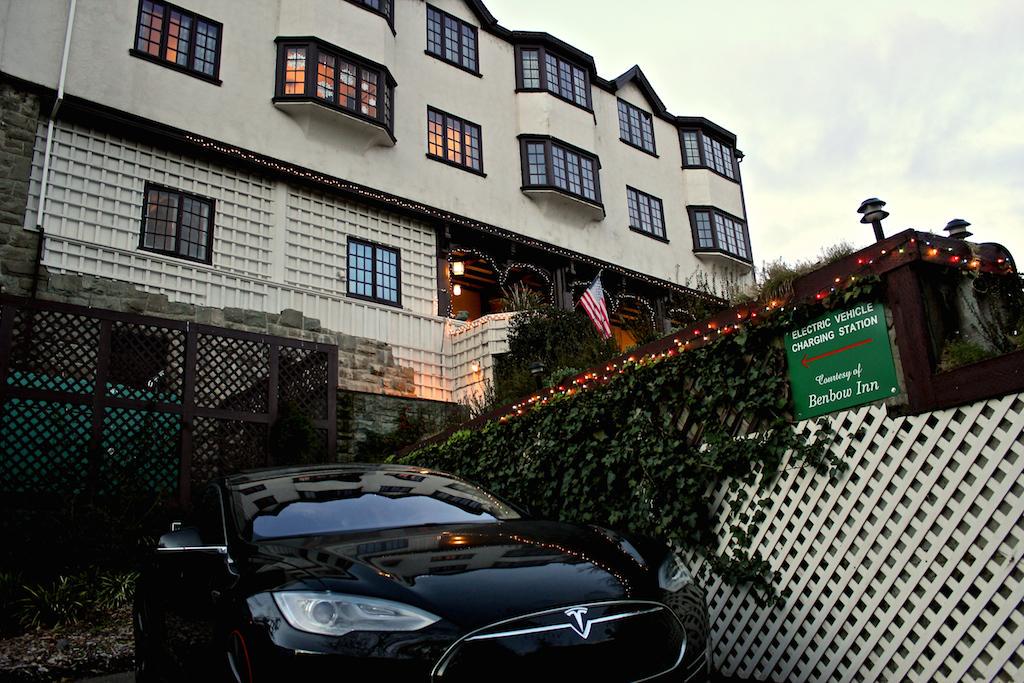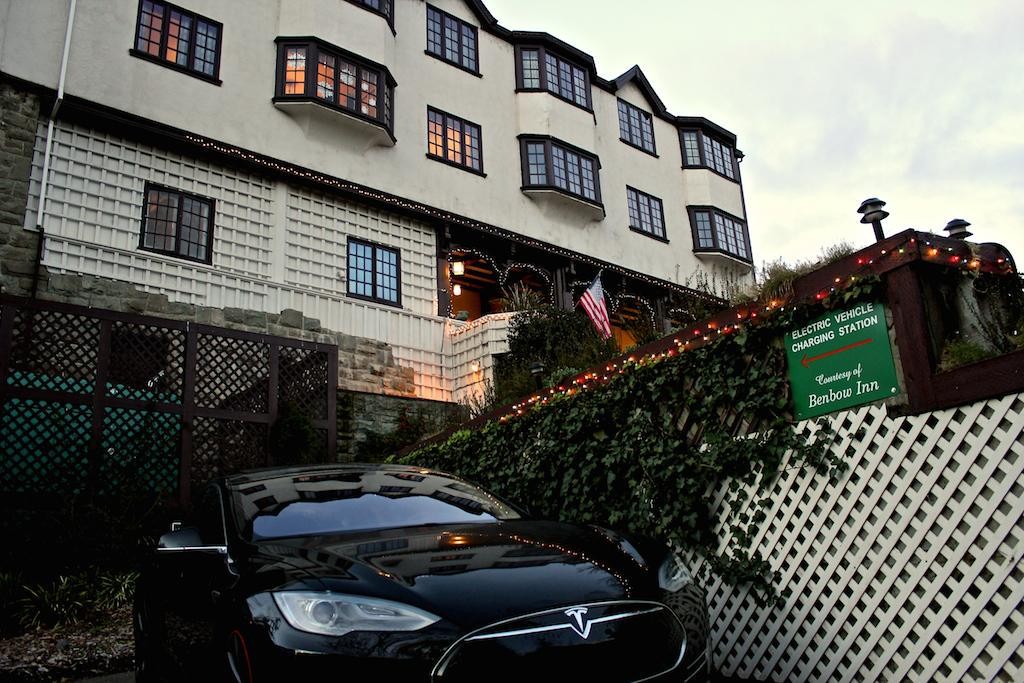Investor's Corner
Tesla Motors: Is Destination Charging Right for You?

Once you buy a Model S, owners want to drive it everywhere it can possibly go and the phrase “destination charging” takes on bigger meaning. Thoughts about taking your SUV for the family trip is now quashed by your desire to drive your electric beast everywhere.
Living in Chicago, my first trip was to Lake Geneva where the hotel proprietor was very receptive in using 120V outlets attached to the ornate light posts in the parking lot. That was two years ago and now more hotel chains and proprietors are installing Tesla’s destination charging solutions, the Tesla high power wall connector. This charging solution offers fast charging at up to 80 amps and can add 59 miles in an hour.
However, raise your hand if you have the twin-charging option on your Model S? Twin-charge is an option for all model variations, not standard even on the P85D, which surprised me.
Last month, Tesla Motors mentioned destination charging in its shareholder letter, pointing to recent installations in the U.S. and Asia.
Tesla’s shareholder letter, date Feb 11, 2015:
As an extension of our Supercharger network, hotels and popular destinations have been installing our high-powered wall connectors at such a rapid pace that we are now coordinating these efforts as a Destination Charging program. Almost 900 locations in Asia and North America currently have 1,600 Tesla connectors installed. We plan to expand the Destination Charging program into Europe in Q2 of this year.
The Q2 comment is interesting due to more focus on high-speed charging in China, where certain media reports cite the lack of charging infrastructure in the most populous country in the world. A recent article in Bloomberg gave more details on the initiative, saying,
“So far, Tesla has largely picked up the tab for the cost of both the charging hardware and the installation. Small lodging establishments benefit because they are listed on Tesla’s website and eventually will appear on the dashboard navigation system.”
Some analysts have bemoaned the rising capital expenditures from the growing company, but this is not completely unfunded due to the added cost option for this hardware, which costs around $1,800 at time of purchase—some on the TMC board noted the cost rises to $3600 for a retrofit.
Daniel Sparks, Motley Fool, and a friend of the program recently estimated that 50,000 Model S cars will be delivered in 2015 (& 5K Model Xs) and let’s say that 1/2 of those deliveries include the twin-charging hardware option. That comes to $4.95 million in additional revenue for a very small component…Musk or somebody at TM knows the luxury segment!
Some hotel or properties also charge a small fee for using these high-powered wall connectors, as most proprietors list the need to be a hotel customer to access the charging points via Tesla’s supercharging map on its site. Right now, Tesla’s destination charging options tilts toward the west and east coast, but the increase in the rest of the country was steady in 2014. Take a look at Indiana, for example.
For customers at this point, destination charging and twin-chargers seem to be the right move.

Investor's Corner
Tesla stock closes at all-time high on heels of Robotaxi progress

Tesla stock (NASDAQ: TSLA) closed at an all-time high on Tuesday, jumping over 3 percent during the day and finishing at $489.88.
The price beats the previous record close, which was $479.86.
Shares have had a crazy year, dipping more than 40 percent from the start of the year. The stock then started to recover once again around late April, when its price started to climb back up from the low $200 level.
This week, Tesla started to climb toward its highest levels ever, as it was revealed on Sunday that the company was testing driverless Robotaxis in Austin. The spike in value pushed the company’s valuation to $1.63 trillion.
Tesla Robotaxi goes driverless as Musk confirms Safety Monitor removal testing
It is the seventh-most valuable company on the market currently, trailing Nvidia, Apple, Alphabet (Google), Microsoft, Amazon, and Meta.
Shares closed up $14.57 today, up over 3 percent.
The stock has gone through a lot this year, as previously mentioned. Shares tumbled in Q1 due to CEO Elon Musk’s involvement with the Department of Government Efficiency (DOGE), which pulled his attention away from his companies and left a major overhang on their valuations.
However, things started to rebound halfway through the year, and as the government started to phase out the $7,500 tax credit, demand spiked as consumers tried to take advantage of it.
Q3 deliveries were the highest in company history, and Tesla responded to the loss of the tax credit with the launch of the Model 3 and Model Y Standard.
Additionally, analysts have announced high expectations this week for the company on Wall Street as Robotaxi continues to be the focus. With autonomy within Tesla’s sights, things are moving in the direction of Robotaxi being a major catalyst for growth on the Street in the coming year.
Elon Musk
Tesla needs to come through on this one Robotaxi metric, analyst says
“We think the key focus from here will be how fast Tesla can scale driverless operations (including if Tesla’s approach to software/hardware allows it to scale significantly faster than competitors, as the company has argued), and on profitability.”

Tesla needs to come through on this one Robotaxi metric, Mark Delaney of Goldman Sachs says.
Tesla is in the process of rolling out its Robotaxi platform to areas outside of Austin and the California Bay Area. It has plans to launch in five additional cities, including Houston, Dallas, Miami, Las Vegas, and Phoenix.
However, the company’s expansion is not what the focus needs to be, according to Delaney. It’s the speed of deployment.
The analyst said:
“We think the key focus from here will be how fast Tesla can scale driverless operations (including if Tesla’s approach to software/hardware allows it to scale significantly faster than competitors, as the company has argued), and on profitability.”
Profitability will come as the Robotaxi fleet expands. Making that money will be dependent on when Tesla can initiate rides in more areas, giving more customers access to the program.
There are some additional things that the company needs to make happen ahead of the major Robotaxi expansion, one of those things is launching driverless rides in Austin, the first city in which it launched the program.
This week, Tesla started testing driverless Robotaxi rides in Austin, as two different Model Y units were spotted with no occupants, a huge step in the company’s plans for the ride-sharing platform.
Tesla Robotaxi goes driverless as Musk confirms Safety Monitor removal testing
CEO Elon Musk has been hoping to remove Safety Monitors from Robotaxis in Austin for several months, first mentioning the plan to have them out by the end of 2025 in September. He confirmed on Sunday that Tesla had officially removed vehicle occupants and started testing truly unsupervised rides.
Although Safety Monitors in Austin have been sitting in the passenger’s seat, they have still had the ability to override things in case of an emergency. After all, the ultimate goal was safety and avoiding any accidents or injuries.
Goldman Sachs reiterated its ‘Neutral’ rating and its $400 price target. Delaney said, “Tesla is making progress with its autonomous technology,” and recent developments make it evident that this is true.
Investor's Corner
Tesla gets bold Robotaxi prediction from Wall Street firm
Last week, Andrew Percoco took over Tesla analysis for Morgan Stanley from Adam Jonas, who covered the stock for years. Percoco seems to be less optimistic and bullish on Tesla shares, while still being fair and balanced in his analysis.

Tesla (NASDAQ: TSLA) received a bold Robotaxi prediction from Morgan Stanley, which anticipates a dramatic increase in the size of the company’s autonomous ride-hailing suite in the coming years.
Last week, Andrew Percoco took over Tesla analysis for Morgan Stanley from Adam Jonas, who covered the stock for years. Percoco seems to be less optimistic and bullish on Tesla shares, while still being fair and balanced in his analysis.
Percoco dug into the Robotaxi fleet and its expansion in the coming years in his latest note, released on Tuesday. The firm expects Tesla to increase the Robotaxi fleet size to 1,000 vehicles in 2026. However, that’s small-scale compared to what they expect from Tesla in a decade.
Tesla expands Robotaxi app access once again, this time on a global scale
By 2035, Morgan Stanley believes there will be one million Robotaxis on the road across multiple cities, a major jump and a considerable fleet size. We assume this means the fleet of vehicles Tesla will operate internally, and not including passenger-owned vehicles that could be added through software updates.
He also listed three specific catalysts that investors should pay attention to, as these will represent the company being on track to achieve its Robotaxi dreams:
- Opening Robotaxi to the public without a Safety Monitor. Timing is unclear, but it appears that Tesla is getting closer by the day.
- Improvement in safety metrics without the Safety Monitor. Tesla’s ability to improve its safety metrics as it scales miles driven without the Safety Monitor is imperative as it looks to scale in new states and cities in 2026.
- Cybercab start of production, targeted for April 2026. Tesla’s Cybercab is a purpose-built vehicle (no steering wheel or pedals, only two seats) that is expected to be produced through its state-of-the-art unboxed manufacturing process, offering further cost reductions and thus accelerating adoption over time.
Robotaxi stands to be one of Tesla’s most significant revenue contributors, especially as the company plans to continue expanding its ride-hailing service across the world in the coming years.
Its current deployment strategy is controlled and conservative to avoid any drastic and potentially program-ruining incidents.
So far, the program, which is active in Austin and the California Bay Area, has been widely successful.









